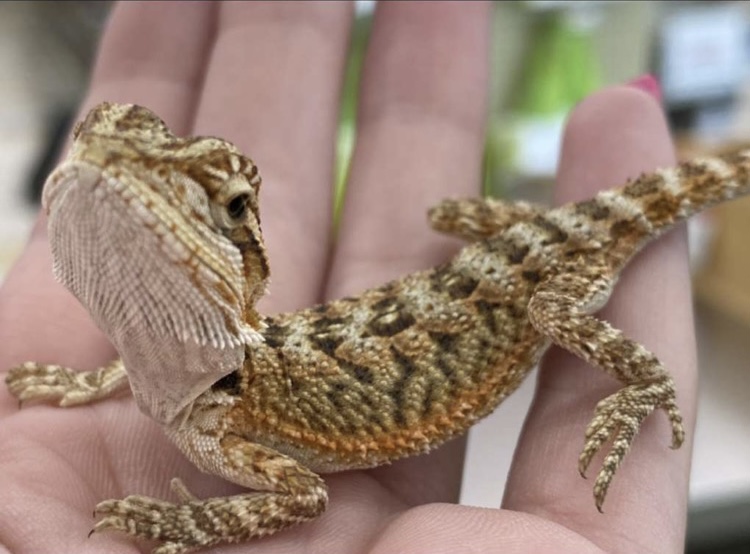Oakland County students with strange pets
A really friendly and sweet fancy bearded dragon being sold at the Milford Pet Supplies Plus.
November 25, 2020
Other than one’s typical dog or cat, which is owned by 48 million Americans, reptiles and small animals are a very common, but strange, household pet. These pets may be “boring” on occasion, but certainly not basic. In America, two percent of pet owners have a reptile, snake, lizard, horse, or hamster. Around one percent owns a rabbit.
Eyelash crested geckos, or crested geckos, are a very uncommon reptile to keep as a pet. Brighton High School senior, Cassie Wright, says she got her gecko, Pongo, after a two-week long hospital visit. “He really helped me cheer up and feel a lot better. It’s a great motivator to keep going when you know something relies on you that much.” Crested geckos can live up to 15 years and grow to be only 10 inches long, making them small and quick. These geckos are different from your usual household pet, as well as any other reptile. Due to their inability to blink, much like leopard geckos, crested geckos will lick their eyes to trap in moisture. Crested geckos also use their tongues for a sense of smell.“[Pongo] loves my dog Jasper and will climb all over him,” expressed Wright. “I have tapestries on my wall and he loves to climb on them.”
When crested geckos feel threatened, they don’t hesitate to detach their tails. However, unlike leopard geckos, crested geckos’ tails won’t grow back. “ Sometimes when he gets away from me, he runs all around my room. [Pongo’s]’s very fast and hard to catch,” said Wright. “He’s super active, but loves to make noise at night. Sometimes when I wake up, I’ll find him chirping, or jumping on the glass [of his tank].” Crested geckos are really great beginner pets, because although they are nocturnal, they’re low-maintenance. “[Pongo] absolutely loves his watermelon pangea food and dusted crickets,” stated Wright. “If you want your pet to be happy and healthy, though, you have to keep up with their hygiene, handling, and humidity.”
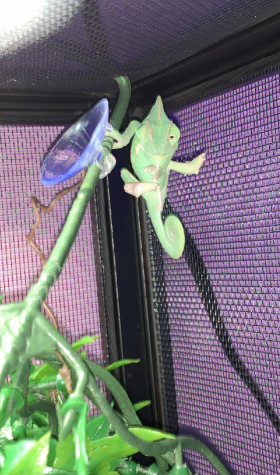
Coming from dry regions of Afghanistan, leopard geckos are a fairly popular pet. Unlike bearded dragons, which can grow to be 26 inches in length, leopard geckos stay approximately ten inches or smaller in length. Shaye Smalley, a Lakeland High School senior, said, “A leopard gecko is probably one of the easiest reptiles to have. They are not hard to take care of, but they’re super fun to have.” These lizards, like crested geckos, make for a really good beginner pet. Milford High School senior Makenna Bastionell currently owns four leopard geckos: Loki, Kabuki, Yoshi, and Tito. “My leopard geckos have pretty hyper personalities, but are different in so many ways,” stated Bastionell.
With the ability to live up to 20 years, these geckos have many different defense mechanisms. With predators such as snakes, foxes, and other large reptiles, a leopard gecko’s keen sense of sight and hearing helps them through the night, as they are nocturnal. Their patterned skin helps them camouflage, but when they feel threatened, leopard geckos will drop their tails, just like crested geckos. Milford High School senior Helena Wilson said, “I rescued [my leopard gecko]. She means a lot to me; I’m always making sure she’s okay. After all, she’s my first pet that hasn’t been a family pet. All the responsibilities are on me.” Leopard geckos have a diet that mainly consists of mealworms, crickets and superworms. Lakeland High School senior Nick Rakestraw said, “My leopard gecko’s name is Applesauce. He has a strict diet of crickets, because he doesn’t eat mealworms, but he is always happy!” Unfortunately, leopard geckos don’t have sticky pads on their feet, like some other lizards. This means they cannot climb up smooth surfaces “My leopard gecko is a snow morph, so he looks really cool because of how light he is,” Smalley said. “He’s really friendly, and will always come outside of his hides when he sees someone.” Bringing a pet home for the first time is, of course, the most exciting part. Milford High School senior Ava Kuhn said, “I got [my leopard gecko] in sixth grade. My brother was getting a pet and I wanted one too, but I wanted mine to look cooler than his, so I settled on a colorful lizard.”
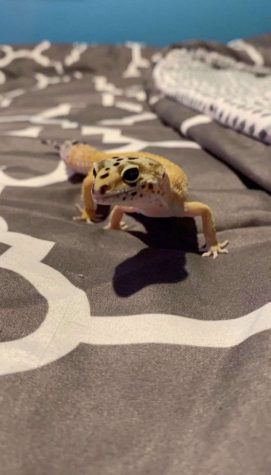
Originating from West Africa, African fat-tailed geckos are a nocturnal and very friendly reptile. Fat-tails don’t mind being handled, unlike a lot of reptiles that aren’t open to be. Although they are not as popular as the well-known leopard gecko or the bearded dragon, fat-tailed geckos are cut out to be equally fascinating pets. Lakeland High School graduate Paige Pearson owns two fat-tailed geckos named Charlie and Teddy. Pearson said, “I saw Charlie sitting in the pet store for months and nobody would buy her, so I decided to take her home one day. About a year later, I did the same thing with Teddy; Charlie needed a friend.” These reptiles also make a great first-time pet. They are easy to take care of because they come from a dry and humid environment, but of course, like any pet, they require some work. “They both don’t move around much,” said Pearson, “but they do like to dig holes in their substrate and follow one another around. They tend to be on the same side [of the tank] as each other.” Fat-tailed geckos generally eat insects such as mealworms, hornworms, waxworms, and crickets. When housing two fat-tailed geckos together, you have to be aware of their territorial tendencies. Often, you will only see two females, or one male and female, put together for that reason; they can get aggressive. “Charlie was very into Teddy when I first got him, but Teddy wanted nothing to do with him until two months ago when they finally decided to be best friends,” Pearson said.
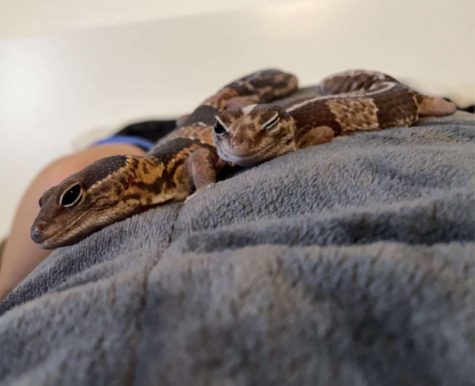
One of the largest reptiles that can be sold in a pet store is a bearded dragon. (unless you’re the man in Milford, MI with an alligator). These lizards are incredibly friendly, active and they love to be handled. You can find these lizards in parts of Australia, but they are most commonly known for being American pets. “My bearded dragon is my little dragon friend who I hang with when I do my homework,” Milford High School senior Aidan Wilson says. “He is such a character— he makes me laugh all the time!” These “large scale” lizards grow to be approximately 26 inches on occasion, almost as big as their personalities. “These little ‘beardies’ have some very strange features to them,” said Wilson. “They have a beard-like coat of scales on their neck, which turns black when they are alarmed or aggravated.”
Generally, these are the easiest reptiles to care for; one must spray a bearded dragon’s cage at least twice a day, feed it crickets, mealworms, or hornworms, and change its cage’s lights. On occasion, people introduce their bearded dragons to a dry veggie mix that can be stirred in with water; this can be used for extra nutrients or a food alternative. “My bearded dragon only eats super worms and some veggies,” said Milford High School graduate Nicole Aubry. “His favorite veggie mix is collard greens, sugar peas, and broccoli.” Bearded dragons must be bathed at least every four to eight days. They will float around and puff up when bathed; in Wilson’s words, “My number one tip is to see if your Bearded Dragon likes water, because mine loves swimming!” Bringing them home is especially exciting for some. Aubry said, “I got my Bearded Dragon when I worked at Brighton Pet Supplies Plus. We had gotten three of them, but I had a special connection with one. I then took him home and my nephew named him Beardy.”
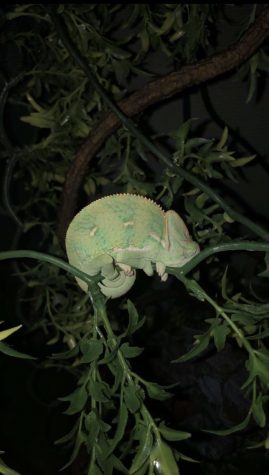
These types of pets can be pretty unique; for example, veiled chameleons have tongues twice the length of their bodies. Due to their eyes focusing in different directions, they physically can’t see still objects or what’s directly in front of them. You can only feed chameleons live crickets, roaches, or mealworms. Otherwise, their food won’t be visible to them. Milford High School graduate Riley Wyskiel expressed how his chameleon differs from other reptiles, saying, “One of my favorite things about chameleons is their technique of catching food. They have a rather long and sticky tongue, which then shoots out to catch any small bugs.” Real life chameleons may not be as cool as Pascal from the movie Tangled, but there is no denying that these reptiles change colors, just not quite not how Pascal does. When chameleons are stressed, they turn dark gray or black. When they are thriving, happy, or excited, they will turn bright green. Wyskiel also stated that “chameleons are very shy in nature. When they feel threatened, they darken their color and puff up to appear bigger, and fend off any incoming threat.” Chameleons are not very easy beginner pets because of their high stress levels. Their enclosure has to maintain a high humidity, along with being sprayed with water every few hours, but with the right knowledge, they can make interesting pets! Wyskiel has owned his chameleon, Pax, for around seven months, making it his first pet. Wyskiel said, “I wanted my first pet to be something different. With a chameleon, you can’t train them, so they will always act and do as they want. I enjoy his enclosure, it’s as if I took a part of nature and put it right in my house.”
Reptiles are a very personal and interesting pet to own, but they aren’t for everyone. Most dislike the fact that crickets or mealworms basically become one’s second pet due to the fact that those are what reptiles eat— some find it unsettling. Others own reptiles and lizards because of their uniqueness, as well the learning an owner must partake in. Check out what local pet stores have to offer, and maybe adopt one of these peculiar pets. Pet Supplies Plus in Milford, Michigan has everything from friendly bearded dragons, to crawling chameleons, and adorable gargoyle geckos; give one of these fascinating pets a home today!
